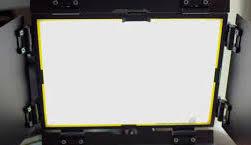What is REMOTE PHOSPHOR Technology?
You´ve heard it before, your cinematographer colleagues are talking about it, but if you were asked to explain what it actually is, you may not know how to answer, other than it is a technology that makes LED lights better.
Phosphor may ring a bell.
It has the ability to light up when stroked by electrons and is used in glow-in-the-dark materials and fluorescent lights. But, phosphor is also used in traditional LEDs you usually work with, so what´s the difference...?
True enough, phosphor is used both in standard LED lights and in Remote Phosphor Technology.
With traditional LED lights a phosphor coating is applied directly on to blue LEDs to make white light.

When the LED is turned on and the temperature rises, this causes the:
- brightness,
- color and
- afterglow duration
of the emitted light to change.
The key is the word REMOTE.
With Remote Phosphor Technology...
phosphor is still used, however what makes this technique better is that instead of putting the phosphor directly on to the LED,
... the phosphor is instead applied to a separated phosphor panel, which is placed in front of the LEDs.

In this way the rising temperature of the LED doesn´t stress the phosphor, and the:
- color,
- brightness and
- duration of the afterglow
stay unchanged.
This means you get a consistent color temperature and a higher TLCI that allows you to match daylight and Tungsten color temperatures extremely well.
Additionally a number of other benefits also follow when using a phosphor panel.
As pointed out earlier, the phosphor itself has the ability to light up. So when the LED light strikes the phosphor, the entire panel illuminates.
This means you get a soft, even light instead of a white plastic panel with a lot of shiny spots on it:


No Thank You Yes Please
This bigger lit surface also ensures you get some nice “ultra" soft shadows that seem to wrap around a person´s face, when facing a person.

It´s almost like this compact unit lights up as a significantly larger unit would do.
The entire lumen output is also enhanced by the phosphor panel,
because it is adding light instead of loosing it as other diffusers do.
Thus, the energy conversion using remote phosphor panels is very efficient, and yields higher light output yet requires less energy use. So it is environmentally smart and less expensive to operate.
Compared standard LEDs with comparable output, there is power draw and of course less heat.
How long has Remote Phosphor been used for lighting?
BB&S Lighting is one of the pioneers in using Remote Phosphor.
We started using the technology in 2012 in our...
BB&S Area 48 Soft and Area 48 Studio
which won the TVBEurope´s Best of IBC Award.
Users can easily interchange a variety of color temperature phosphor panels to fit in front of the LEDs on an Area 48.
And the great thing about this is, that no matter if you choose a 2700°K, 5600°K, 10.000°K or one of the Chroma panels, the output is always 98 TLCI, because the same amount of light is generated regardless which phosphor panel is used.
The separation of the phosphor from the LEDs also allows an extra benefit that enhances the brightness even more.
Behind the LEDs, BB&S lights feature an optical white mixing chamber that bounces all wavelengths of the light equally to make sure 99% of the bouncing light is reflected.
Cinematographer Todd Heater was very satisfied when he used the Area 48:
“The color match to daylight was as close to daylight as I’ve seen on the market, and probably better than all the other LEDs that I’ve seen out there. I have a more artistic approach to lighting than a technical one, but to my eye and to the camera,
“the color is right on the money.”
Another advantage, he added, was that you can:
"dim them down without changing color temperature. Now we can work at really, really low levels while remaining locked on in terms of color temperature"
Since introducing the Area 48s BB&S Lighting has used Remote Phosphor Technology in several lighting fixtures.



